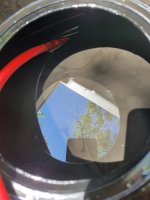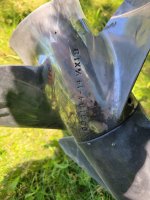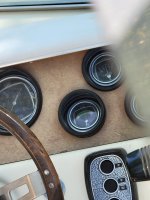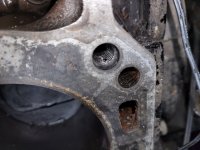Ok so this weekend was the first time I was able to get the boat out on the lake since I purchased and did some repairs to it. I have a few questions. The motor is a Ford 351W (Mercruiser 233) SN: 4677439 and it is hooked up to an MC-1 outdrive (do not know the SN all the stickers are very worn).
First off Saturday it started really hard then ran rough when in gear and stalled repeatedly. So retrailered it and brought it home for some troubleshooting and repairs (hopefully). I had filled it with what I thought was ethanol free 93 but noticed at the pump friday that it had a 10% ethanol sticker in it. So the boat had a combination of about 5-10 gallons of fuel that was lord knows how old (but it started and seemed to run fine without load) and 20-25 gallons of 10% ethanol 93 that was 3 weeks old. So when we got home we drained the fuel and changed all the spark plugs. The old plugs were carbon fouled. We then found a station with ethanol free 91 (triple checked it this time) and filled the boat up with a couple of cans of Seafoam as well (28.5 gallons of fuel, 32 oz Seafoam, the remainder of the 30 gallon tank left over old fuel and probably some water). Took it home and started the boat up and it ran 100x better. To be completely honest I thought about changing the spark plugs and draining the fuel immediately after I brought it home but talked myself out of it because I'm smart (s-m-r-t) like that.
Now onto today, I put the boat in the water and it started first try no additional throttle needed, idled great, and went into gear no problem. I added throttle and it got on plane (a little slower than expected with just me, a cooler of water, bag of towels and a small toolset just in case) but the engine didn't seem to want to go above 3k RPM even with trim. I tried to get on plane again after this but I think I forgot to lower the trim because it just sent the nose to the sky. So I probably screwed up my attempt to replicate the situation. Does this sound like a carb issue or the prop being too steep (picture of prop pitch below).
Brought it off plane to pick up the wife and I noticed the temp gauge was in the red (no idea what temp that is the gauge is just yellow then green then red). I immediately shut off the motor then went and lifted the cowl. It was arguably cool in there and the I didn't feel any heat even radiating from the engine. I started the boat to see if letting it idle and pull water with no load would help and the needle sat in the red for a second then jumped to smack dab in the middle of the green bar. Then it sat there for a while and jumped back to the middle of the red bar. It never pegged all the way to the end of the gauge only ever to the middle of the sections. It also never gradually went to the spot it was always a jump in the blink of an eye. I have attached a picture of the temp gauge below. Any ideas on what the issue could be here? I do not have a temp gun to point at the engine and it seems odd that it would jump back and forth.
When we got back from the lake I decided to drain the engine oil because I had not changed that between me owning it and the previous owner as well. Below are pictures of what was pulled out via the dipstick tube. It is definitely murky and has water. it was about a 1/16" (maybe an 1/8") over full on the dip stick when I pulled it to check. Today was the second time the boat was in the water since I have owned it and only for probably 2 hours total. it has been on muffs for probably about an hour or 2 as well. Does this seem like a manifold leak or is it more likely that there was water in the oil from condensate for sitting for a couple of years and then when it ran it emulsified it? I've seen other posts about water in oil but they seemed to me to be a different color than this.
Mods let me know if I was supposed to split this into multiple posts and I will do so. I couldn't see to find the preferred method for multiple questions at once in the rules and apologize if I missed it.
First off Saturday it started really hard then ran rough when in gear and stalled repeatedly. So retrailered it and brought it home for some troubleshooting and repairs (hopefully). I had filled it with what I thought was ethanol free 93 but noticed at the pump friday that it had a 10% ethanol sticker in it. So the boat had a combination of about 5-10 gallons of fuel that was lord knows how old (but it started and seemed to run fine without load) and 20-25 gallons of 10% ethanol 93 that was 3 weeks old. So when we got home we drained the fuel and changed all the spark plugs. The old plugs were carbon fouled. We then found a station with ethanol free 91 (triple checked it this time) and filled the boat up with a couple of cans of Seafoam as well (28.5 gallons of fuel, 32 oz Seafoam, the remainder of the 30 gallon tank left over old fuel and probably some water). Took it home and started the boat up and it ran 100x better. To be completely honest I thought about changing the spark plugs and draining the fuel immediately after I brought it home but talked myself out of it because I'm smart (s-m-r-t) like that.
Now onto today, I put the boat in the water and it started first try no additional throttle needed, idled great, and went into gear no problem. I added throttle and it got on plane (a little slower than expected with just me, a cooler of water, bag of towels and a small toolset just in case) but the engine didn't seem to want to go above 3k RPM even with trim. I tried to get on plane again after this but I think I forgot to lower the trim because it just sent the nose to the sky. So I probably screwed up my attempt to replicate the situation. Does this sound like a carb issue or the prop being too steep (picture of prop pitch below).
Brought it off plane to pick up the wife and I noticed the temp gauge was in the red (no idea what temp that is the gauge is just yellow then green then red). I immediately shut off the motor then went and lifted the cowl. It was arguably cool in there and the I didn't feel any heat even radiating from the engine. I started the boat to see if letting it idle and pull water with no load would help and the needle sat in the red for a second then jumped to smack dab in the middle of the green bar. Then it sat there for a while and jumped back to the middle of the red bar. It never pegged all the way to the end of the gauge only ever to the middle of the sections. It also never gradually went to the spot it was always a jump in the blink of an eye. I have attached a picture of the temp gauge below. Any ideas on what the issue could be here? I do not have a temp gun to point at the engine and it seems odd that it would jump back and forth.
When we got back from the lake I decided to drain the engine oil because I had not changed that between me owning it and the previous owner as well. Below are pictures of what was pulled out via the dipstick tube. It is definitely murky and has water. it was about a 1/16" (maybe an 1/8") over full on the dip stick when I pulled it to check. Today was the second time the boat was in the water since I have owned it and only for probably 2 hours total. it has been on muffs for probably about an hour or 2 as well. Does this seem like a manifold leak or is it more likely that there was water in the oil from condensate for sitting for a couple of years and then when it ran it emulsified it? I've seen other posts about water in oil but they seemed to me to be a different color than this.
Mods let me know if I was supposed to split this into multiple posts and I will do so. I couldn't see to find the preferred method for multiple questions at once in the rules and apologize if I missed it.
























